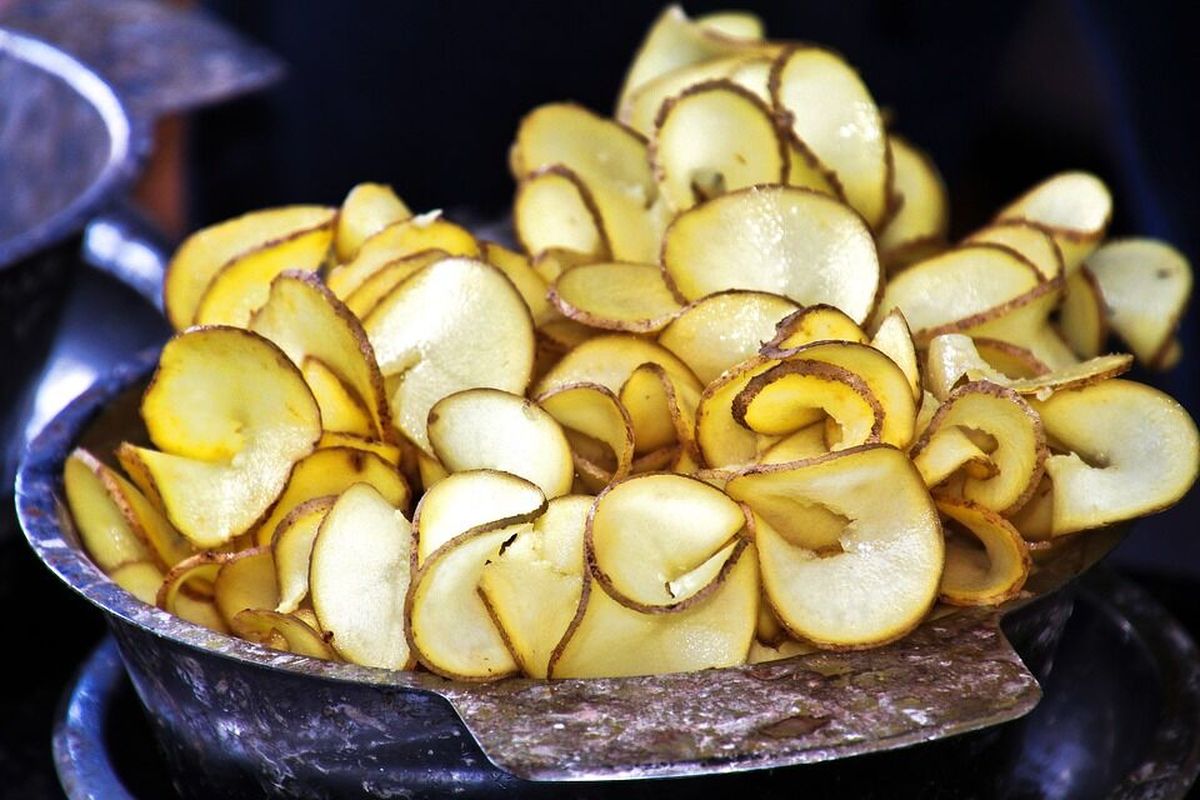
Everyone knows the sense of disappointment that follows ripping open a fresh bag to potato chips only to discover that two-thirds of it is air. One way around this is to make your own. Whether you praise the delicately thin potato chip or swear by the thicker, kettle style, homemade potato chips are worth the time and effort.
Industrially made chips have been around since the early 1900s, and they were all created in the kettle system, cooked in a big pot of oil in batches. Around the mid-20th century, potato chip companies began using converter belt systems to fry and dry chips in one, continuous process. This process resulted in a paler, thinner and lighter chip that most have come to know and love today. Kettle chip style had a revival around the 1980s and has since gained more popularity, with many of the largest chip producers creating a kettle style within their brand.
The science behind the potato chip is just as beautiful as its taste. An uncooked potato slice is full of water, starch and sugar and is flexible and limp. When this potato slice hits hot oil, its water content begins to evaporate. The bubbles that occur during frying is the indication of evaporating water. The spaces within the chip that the water left behind will now fill with oil. The sugar and starch begin to cook and the potato hardens, trapping all the tasty, absorbed fats inside.
The trick to a successful potato chip is to ensure the inside dehydrates before the outside begins to harden and burn. If any water remains in the chip, it will be soggy, in other words, it will be the antithesis to a chip. There are a few key elements required to avoiding limp chips.
To start, you need to use the right variety of potato. Many commercial chip suppliers use a specialist crisping variety of potato called the Lady Rosetta, but we individual consumers make due with the classic russet potato in order to create a crunchy, sturdy chip.
Next, slice the potatoes very thin. Within 1-3 millimeters is the average range, but you can adjust the thickness to your preference. A mandolin or electric slicer will be some of the best tools for this task, but to keep it simple, use a peeler. It may not create the most beautifully round chip, but it will ensure all the slices have a consistent thickness with little effort.
For a light, blonde, supermarket style chip, start by rinsing the slices well, until the water runs clear. Parboil in water with a splash of white vinegar for about 4 minutes. Then drain and pat them dry on a towel. Fry in small batches in neutral oil at 320-340 degrees Fahrenheit. Use enough oil, about 2 to 3 inches, so that the slices can all be submerged. They are done when they turn a light golden color, and the bubbles stop. Remove from the oil, place on a paper towel and immediately salt to taste.
The parboil in this method removes excess sugar, and the addition of vinegar slows its cooking, resulting in less burning, lighter color and less crunch.
For a thicker chip with deeper flavor, lightly rinse the slices and skip the blanch.
One alternative method is to lightly rinse the chips, skip the blanch, then add them to cold oil and slowly let everything come up to heat on medium-high. This takes at least 30 minutes or longer until everything is golden brown, but it is fewer steps.
Try it out and see how your homemade chips hold up to what you buy at the store.
Rachel Baker can be reached at (509) 459-5583 or rachelb@spokesman.com
"chips" - Google News
January 07, 2021 at 10:25AM
https://ift.tt/3bfb4Wd
Water Cooler: Homemade potato chips are worth the effort - The Spokesman-Review
"chips" - Google News
https://ift.tt/2RGyUAH
https://ift.tt/3feFffJ
Bagikan Berita Ini















0 Response to "Water Cooler: Homemade potato chips are worth the effort - The Spokesman-Review"
Post a Comment